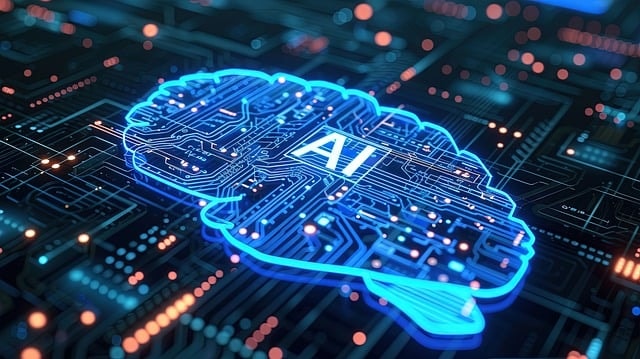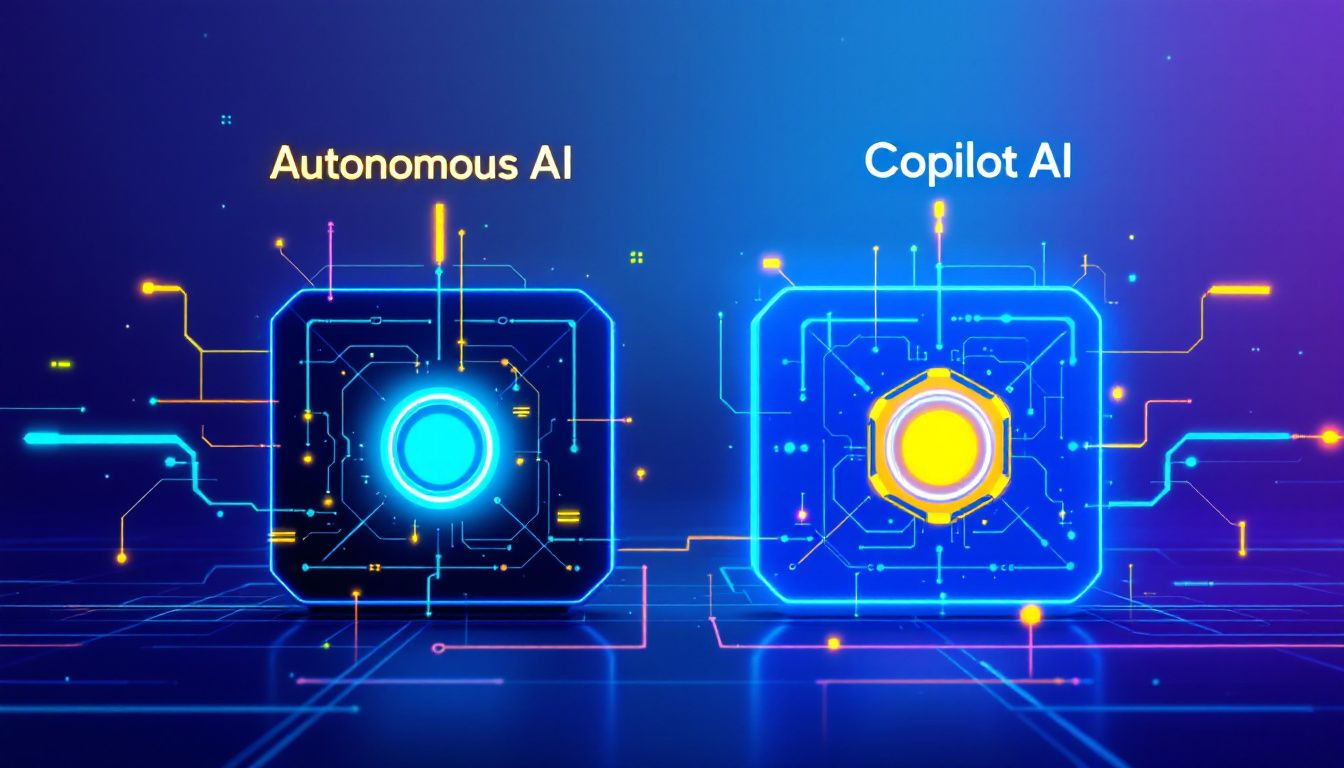Want to know the difference between Autonomous AI and Copilot AI? This article explains how Autonomous AI works independently, while Copilot AI supports human tasks. We’ll explore their key differences and real-world impacts, including autonomous ai vs copilot ai: understanding the key differences and real world impacts.
Key Takeaways
-
Autonomous AI operates independently to perform complex tasks without human intervention, while Copilot AI serves as an assistant that augments human decision-making.
-
Autonomous AI enhances productivity by automating tasks across various sectors like manufacturing and healthcare, whereas Copilot AI improves workflow efficiency and customer interactions by supporting users in their tasks.
-
The successful deployment of both AI types hinges on addressing challenges such as data quality, integration with existing systems, and ethical considerations.
Defining Autonomous AI and Copilot AI

Autonomous AI represents a leap in AI capabilities, enabling systems to detect, recognize, and respond to complex signals independently. These AI agents can perform multi-step tasks without human intervention, leveraging large language models and advanced reasoning capabilities. They are designed to maximize efficiency in task response and enhance critical operations, from industrial monitoring to autonomous driving.
On the other hand, Copilot AI functions as a dynamic assistant, augmenting human capabilities and working collaboratively with users. Unlike Autonomous AI, which operates independently, Copilot AI requires human guidance to execute tasks optimally. Its core characteristic lies in helping users make decisions while maintaining human control, making it an invaluable tool in various professional settings.
Both Autonomous AI and Copilot AI benefit from advancements in deep learning and machine learning, which enhance their ability to recognize patterns and perform tasks with high accuracy. While Autonomous AI focuses on independent problem-solving, Copilot AI excels in supporting and augmenting human decision-making processes. Understanding these distinctions sets the stage for a deeper analysis of their functionalities and real-world applications.
Core Functionalities of Autonomous AI
Autonomous AI operates with minimal human oversight, executing complex tasks and solving problems independently. These AI agents are designed to respond to business signals and adapt their workflows in real-time based on changing conditions and requirements. This capability allows them to streamline complex business tasks, significantly reducing manual inputs and administrative work.
Organizations can tailor autonomous agents to specific workflows, enhancing efficiency and decision-making. These agents can process various input types, including text, images, and numerical data, making them versatile tools in diverse industries. Their ability to interact seamlessly with multiple digital platforms further enhances their operability across different systems.
One of the key features of Autonomous AI is its predictive capability, enabling it to anticipate user needs and identify potential problems before they arise. These agents analyze complex situations in real-time, making informed decisions based on multiple factors. The transparency of their operations fosters trust and allows for effective oversight of their decision-making processes.
Overall, Autonomous AI leverages advanced machine learning models and AI technologies to perform highly analytical, responsive, and scalable tasks automatically. By enhancing detection, recognition, and response capabilities, these intelligent systems contribute to significant productivity and efficiency improvements in various sectors.
Core Functionalities of Copilot AI
Copilot AI acts as a personalized assistant, enhancing individual capabilities while supporting users in their tasks. These AI agents possess dynamic learning abilities, allowing them to adapt and refine their strategies based on user interactions. Context awareness enables Copilot AI to interpret user intent and maintain situational relevance in interactions, making it a valuable tool in professional settings.
Before:
One of the key features of Copilot AI is its integration with various applications to streamline data access and improve workflow efficiency. In OneNote, for instance, Copilot generates content, summarizes notes, and helps clarify writing. In Excel, it aids users in data analysis and creating tailored spreadsheets while extracting key insights. In Outlook, Copilot helps draft and summarize emails, enhancing communication efficiency.
After:
Copilot AI has several key features that enhance workflow efficiency through integration with various applications:
-
In OneNote, Copilot generates content, summarizes notes, and helps clarify writing.
-
In Excel, it aids users in data analysis and creating tailored spreadsheets while extracting key insights.
-
In Outlook, Copilot helps draft and summarize emails, enhancing communication efficiency.
Copilot AI also integrates with Microsoft Teams to organize discussion points, recap conversations, and assist with message drafting, thereby improving team collaboration. The Copilot Prompt Gallery encourages users to explore and share prompts, enhancing their workflow. The Microsoft Copilot Dashboard provides visibility into usage statistics and the impacts of Copilot within organizations, helping users optimize their AI-powered tools.
Overall, Copilot AI enhances productivity by assisting users in various tasks, from generating presentations in PowerPoint to creating dynamic marketing campaigns in SharePoint. Its ability to integrate with external tools and APIs significantly expands its functional range and capabilities, making it a versatile assistant in multiple professional domains.
Key Differences Between Autonomous AI and Copilot AI

While both Autonomous AI and Copilot AI fall under the umbrella of artificial intelligence, their levels of autonomy and decision-making processes set them apart. Autonomous AI operates independently, performing complex tasks without human intervention, whereas Copilot AI enhances human decision-making by providing support and insights.
These differences manifest in various use cases and applications, which we will explore in the following subsections.
Level of Autonomy
A defining feature of Autonomous AI is its ability to operate independently, performing complex tasks without requiring human input. This level of autonomy allows organizations to delegate repetitive tasks to these AI agents, leading to increased efficiency and productivity. For instance, in manufacturing and logistics, Autonomous AI can streamline operations by automating tasks that would otherwise require significant human labor.
In contrast, Copilot AI, while capable of operating autonomously to an extent, relies on human operators for guidance and decision-making. This collaborative approach ensures that human expertise and oversight remain integral to the process, enhancing the overall effectiveness of the AI system. By supporting users in their tasks, Copilot AI allows them to focus on more strategic and creative aspects of their work, ultimately boosting productivity.
The distinction in autonomy levels between Autonomous AI and Copilot AI highlights their unique strengths and applications. While Autonomous AI excels in scenarios that require independent problem-solving and task execution, Copilot AI shines in environments where human-AI collaboration is essential.
Decision-Making Processes
The decision-making processes in AI technologies are crucial for understanding how different AI types approach tasks and interactions with humans. Autonomous AI utilizes sophisticated AI models and extensive data analysis to make decisions independently, functioning without human intervention. These AI agents continuously learn from their environment, adapting their strategies to optimize performance and outcomes.
On the other hand, Copilot AI relies on collaboration with human users, augmenting their decision-making through suggestions and insights. By analyzing user inputs and providing relevant recommendations, Copilot AI enhances the decision-making process without taking full control. This approach ensures that human expertise and judgment remain central to the process, allowing for more informed and balanced decisions.
The key difference lies in autonomy: while Autonomous AI performs tasks independently, Copilot AI enhances human decision-making through support and collaboration. This distinction is particularly evident in applications such as marketing campaigns, where Copilot AI aids in the creative process without overshadowing human creativity and intuition.
Use Cases and Applications
Copilot AI excels at automating repetitive tasks. This includes responding to customer inquiries, scheduling appointments, and processing invoices. By handling these routine tasks, Copilot AI frees up human operators to focus on more complex and value-added activities, enhancing overall efficiency and productivity. In customer service, for instance, Copilot AI can manage customer queries and provide timely responses, improving customer satisfaction and experience.
Autonomous AI, on the other hand, has significant use in optimizing operational costs across various industries. For example, in industrial operations, Autonomous AI can monitor equipment, predict maintenance needs, and optimize production processes without human intervention. This capability leads to more efficient processes, reduced labor costs, and improved operational performance.
The diverse use cases and applications of Autonomous AI and Copilot AI demonstrate their unique strengths and potential benefits. While Copilot AI excels in enhancing customer interactions and supporting human operators, Autonomous AI contributes to significant productivity and efficiency improvements in various sectors.
Real-World Impacts of Autonomous AI

The real-world impacts of Autonomous AI are profound and far-reaching, transforming industries and enhancing operational efficiency across various sectors. From manufacturing to transportation and healthcare, Autonomous AI is driving significant productivity gains and improving safety and decision-making processes.
Let’s explore some of these impacts in more detail.
Enhancing Productivity in Manufacturing
Autonomous AI enhances operational efficiency in manufacturing by automating various processes and reducing the need for human intervention. By deploying AI-powered tools, manufacturers can streamline operations, minimize errors, and optimize resource allocation. This automation not only boosts productivity but also allows human workers to focus on more strategic tasks, enhancing overall operational effectiveness.
For instance, Toyota’s implementation of AI in its manufacturing process has significantly reduced man-hours, resulting in enhanced efficiency and productivity. The use of AI technologies in manufacturing leads to operational availability, accuracy, and significant risk management improvements, positively impacting manufacturing productivity. By automating repetitive tasks, manufacturers can achieve greater consistency and reliability in their production processes, ultimately leading to higher quality products and improved customer satisfaction.
Moreover, the integration of Autonomous AI in manufacturing contributes to employee satisfaction by reducing the burden of monotonous and physically demanding tasks. This shift not only improves workplace safety but also allows employees to engage in more creative and value-added activities, fostering a more innovative and motivated workforce.
Overall, the deployment of Autonomous AI in manufacturing represents a significant step towards enhancing productivity and streamlining processes in the industry.
Improving Safety in Transportation
Autonomous vehicles are revolutionizing the transportation industry by improving safety and minimizing human errors, which are a leading cause of accidents. These AI-powered vehicles can navigate roads and environments without human intervention, enabling them to deliver goods, transport passengers, and conduct inspections with greater precision and reliability. By leveraging advanced AI technologies, autonomous vehicles can make real-time decisions that enhance safety and efficiency in transportation systems.
Autonomous buses and trains optimize routes and improve scheduling in public transit. They also contribute to increased safety. These intelligent systems can analyze traffic patterns, weather conditions, and other variables to make informed decisions that enhance the overall safety and reliability of public transportation. The use of AI in transportation also allows for better resource allocation and reduced operational costs, leading to more efficient and sustainable transit systems.
Advances in AI are also transforming public safety by enabling real-time decision-making in transportation. For example, AI-powered traffic management systems can monitor and control traffic flow, reducing congestion and improving road safety. By minimizing human errors and optimizing transportation processes, autonomous AI is playing a crucial role in enhancing safety and efficiency in the transportation industry.
Transforming Healthcare with Intelligent Systems
AI technologies are revolutionizing healthcare by reducing diagnostic errors and enhancing patient monitoring, leading to better healthcare outcomes. Intelligent systems, such as AI-powered diagnostic tools and virtual assistants, can analyze vast amounts of medical data to provide accurate and timely diagnoses. These advancements not only improve patient care but also enhance the efficiency of healthcare providers by automating routine tasks and streamlining processes.
Robots are also playing a significant role in healthcare by aiding surgeons, delivering medications, and supporting patient care. For instance, the U.S. Department of Veterans Affairs is utilizing AI to improve cancer detection for service members and veterans, which is part of a larger trend where AI enhances diagnostic processes. These intelligent systems can assist in complex surgical procedures, ensuring precision and reducing the risk of complications.
Autonomous AI technologies are further transforming healthcare by enhancing operational efficiency and patient care. For example, AI-powered virtual assistants can schedule appointments, manage patient records, and provide personalized health recommendations. By automating these tasks, healthcare providers can focus on delivering high-quality care and improving patient outcomes.
The integration of AI in healthcare represents a significant advancement in medical science, offering new possibilities for diagnosis, treatment, and patient management. Overall, the deployment of AI technologies in healthcare is driving significant improvements in operational efficiency, patient care, and diagnostic accuracy. By leveraging the power of AI, healthcare providers can enhance their capabilities, reduce costs, and deliver better outcomes for patients.
Real-World Impacts of Copilot AI

Copilot AI is making a significant impact across various industries by enhancing workplace productivity and improving customer experiences. From financial transactions to retail and marketing, Copilot AI is transforming the way businesses operate and interact with their customers.
Let’s delve into some of the key real-world impacts of Copilot AI.
Boosting Efficiency in Financial Transactions
AI implementation in financial transactions has led to significant reductions in errors and enhanced productivity. For instance, Enpal achieved a reduction in quote generation time from 120 minutes to 15 minutes (87.5%) through automation. By leveraging AI-powered tools, financial institutions can streamline processes, optimize operations, and reduce operational costs. These advancements allow financial professionals to focus on more strategic tasks, ultimately enhancing productivity and efficiency.
Fundwell utilizes AI to analyze financial health, matching businesses with suitable funding solutions. By automating financial data analysis, AI agents can identify patterns that detect fraud, optimize spending, and improve budgeting. This capability not only enhances financial security but also provides valuable insights that help businesses make informed decisions.
AI-powered chatbots free up time for human support teams to focus on complex cases, enhancing customer service. For example, Credem enhances online security, tailors products to customer needs, and predicts software malfunctions through AI in financial services. By leveraging AI technologies, financial institutions can improve customer interactions, enhance security, and optimize their operations, ultimately boosting efficiency in financial transactions.
Enhancing Customer Experience in Retail
AI chatbots are transforming the retail industry by resolving customer inquiries around the clock, providing immediate and efficient responses. These intelligent chatbots can handle a wide range of customer queries, from product recommendations to order tracking, enhancing the overall customer experience. By leveraging AI technologies, retailers can improve customer satisfaction and loyalty by providing personalized and timely support.
Intelligent chatbots are used in organizations to transform customer interactions. For example, NotCo utilizes a conversational AI chatbot powered by Gemini to improve data access and streamline customer service. Similarly, Alaska Airlines’ AI technology provides a conversational experience for travel booking, enhancing the ease and convenience of the booking process.
Abstrakt enhances customer experiences in contact centers by transcribing calls and evaluating sentiment in real-time. By analyzing customer interactions, AI agents can provide hyper-personalized support, making customers feel valued and understood. This level of personalization not only improves customer satisfaction but also drives sales and increases overall business performance.
Supporting Creative Processes in Marketing
AI tools are revolutionizing the efficiency of content creation processes, allowing marketing teams to produce high-quality materials in less time. For instance, Connected-Stories transforms digital content creation and optimization using generative AI, enabling marketers to create engaging campaigns quickly and efficiently. This capability allows marketing teams to focus on strategic planning and creative ideation, enhancing overall productivity.
Adore. Me marketers used Google Gemini, reducing their product description process from 30-40 hours to one hour. By leveraging AI-powered tools like Jasper, marketing teams can craft high-converting copy, social media content, and blog outlines with ease. These tools not only streamline the creative process but also ensure consistency and quality in marketing materials.
Procter & Gamble enhanced their marketing team’s efficiency by accelerating the creation of photo-realistic images using Imagen. Similarly, Carrefour’s Marketing Studio streamlines the creation of dynamic campaigns across social networks, allowing for more targeted and effective marketing efforts. These advancements demonstrate the transformative potential of AI in supporting creative processes and enhancing marketing productivity.
Monks achieved an 80% improved click-through rate and 46% more engaged visitors using Google Gemini for their ad campaign. Tools like Anyword generate marketing copy, product descriptions, website content, and social media posts, integrating with multiple platforms to enhance marketing efficiency. By supporting creative processes in marketing, AI technologies empower marketing teams to deliver impactful and engaging campaigns that drive business growth.
Challenges and Considerations
While the benefits of AI technologies are immense, there are also challenges and considerations that need to be addressed. Issues such as data quality, privacy concerns, integration with existing systems, and ethical and security considerations are critical to the successful deployment of AI solutions.
Let’s explore these challenges in more detail.
Data Quality and Privacy Concerns
Maintaining data quality is essential for the effective performance of AI systems. Regularly reviewing and refining the performance of AI systems based on feedback is crucial for ensuring data accuracy and reliability. However, black-box algorithms in AI systems can obscure inputs and operations from users, creating challenges for data transparency. To prevent unintended actions by AI agents, it is important to provide clear boundaries for agent autonomy.
Data privacy is another significant concern in AI operations. Intelligent contextual security assessments, like those provided by AppOmni, enhance data privacy during AI operations by identifying and mitigating potential risks. Ensuring strong technical infrastructure and regularly evaluating AI agents are crucial for ethical AI deployment. By addressing data quality and privacy concerns, organizations can build trust and ensure the responsible use of AI technologies.
The management of structured and unstructured data is also critical in AI operations. AI systems need to analyze vast amounts of historical data, financial data, and customer data to provide valuable insights and make informed decisions. Ensuring data security and protecting against unauthorized access are paramount to maintaining the integrity and confidentiality of sensitive information. By implementing robust data management practices, organizations can mitigate risks and enhance the overall effectiveness of their AI solutions.
Overall, addressing data quality and privacy concerns is essential for the successful deployment of AI technologies. By maintaining high standards of data accuracy, transparency, and security, organizations can ensure the ethical and responsible use of AI, ultimately enhancing customer interactions and operational efficiency.
Integration with Existing Systems
Integrating autonomous systems into existing infrastructures often leads to compatibility issues due to differences in operational protocols and data formats. The convergence of different autonomy levels among systems in an autonomous system of systems (SoAS) can complicate data sharing and interaction. These challenges highlight the need for careful planning and coordination to ensure seamless integration and interoperability.
Legacy systems may impose constraints that hinder the integration of newer autonomous technologies, affecting the overall system architecture. Ensuring cybersecurity during the integration of autonomous systems is critical to protect against unauthorized access and data breaches. By addressing these challenges, organizations can enhance the compatibility and security of their AI solutions.
Successful integration of autonomous systems requires a clear understanding of both technical and organizational factors impacting system interoperability. By aligning technical requirements with organizational goals, businesses can ensure a smooth transition and maximize the benefits of AI technologies. Streamlining processes and automating tasks through intelligent systems can significantly enhance operational efficiency and customer interactions.
Overall, addressing integration challenges is crucial for the successful deployment of autonomous AI solutions. By ensuring compatibility, security, and interoperability, organizations can leverage the full potential of AI technologies to enhance their operations and deliver better outcomes.
Ethical and Security Concerns
The deployment of autonomous AI raises ethical questions about job displacement and labor dynamics. While automation with AI reduces operational costs by saving employee time and eliminating overtime costs, it also leads to potential security issues related to decreased workforce oversight. Addressing these ethical and security concerns is essential for the responsible use of AI technologies.
Ensuring data security and privacy is paramount in AI operations. AI agents need to handle sensitive information, such as customer queries and financial data, with utmost care to prevent data breaches and unauthorized access. Implementing robust security measures and regularly evaluating AI systems can help mitigate these risks and ensure the ethical use of AI.
Moreover, organizations must consider the broader societal impact of AI deployment. By promoting transparency, accountability, and fairness in AI operations, businesses can build trust and ensure the responsible use of AI technologies. Addressing ethical and security concerns is crucial for maximizing the benefits of AI while minimizing potential risks and negative impacts.
Future Trends in AI Technologies

The future of artificial intelligence is expected to see a continued evolution beyond current expectations. Emerging trends in AI technologies are transforming industries through business automation and AI integration.
Let’s explore some of the key future trends in AI technologies.
Advances in Machine Learning Models
Heightened contextual awareness and deep learning will be vital for autonomous AI agents to enhance user interaction. AI models will implement reasoning paradigms such as deductive, inductive, and abductive reasoning for improved decision-making capabilities. These advancements will enable AI agents to analyze complex situations and provide more accurate and relevant insights.
CytoReason’s AI technology creates computational disease models that significantly shorten clinical trials and reduce drug development costs. By leveraging advanced machine learning models, AI technologies can transform various industries, from healthcare to finance. Maintaining data quality is crucial as flawed decisions can arise from incomplete or biased data.
Overall, advances in machine learning models will drive significant improvements in AI capabilities, enabling more sophisticated and accurate decision-making. These developments will enhance the effectiveness of AI solutions and unlock new possibilities for business automation and optimization.
Evolution of Natural Language Processing
Recent advancements in natural language processing have focused on developing more effective algorithms that can understand context and intent better than before. Innovations such as transformer models and pre-trained language models have significantly improved the performance of NLP systems. These advancements enable AI systems to provide more accurate and relevant responses during interactions with users.
As a result of improved NLP techniques, AI can more effectively interpret emotional cues and nuanced language, leading to a more human-like interaction experience. This enhancement in human-AI interaction capabilities is especially significant in fields such as customer service, healthcare, and education, where communication is crucial.
In the future, we can expect natural language processing to evolve further, incorporating deeper learning and context awareness to enrich human-AI collaboration. Overall, the evolution of natural language processing will enhance the ability of AI systems to understand and respond to human language more effectively. These advancements will drive improvements in customer interactions, healthcare communication, and other areas where effective communication is essential.
Impact on Workforce and Job Roles
Autonomous AI leads to a reduction in labor costs, particularly for repetitive tasks, which helps in optimizing operations. The introduction of autonomous agents is expected to revolutionize workflows and augment human capabilities within organizations. By automating routine tasks, AI technologies free up human workers to focus on more strategic and creative activities, enhancing overall productivity and job satisfaction.
AI technologies continuously monitor processes, flag compliance risks, and perform audits, thus altering job roles related to compliance. As AI agents take on more responsibilities, employees can transition to roles that require higher-level skills and decision-making capabilities. This shift not only enhances employee satisfaction but also drives innovation and growth within organizations.
Overall, the impact of AI on the workforce will lead to significant changes in job roles and responsibilities. By augmenting human capabilities and optimizing operations, AI technologies will drive improvements in productivity, efficiency, and employee satisfaction.
Summary
In summary, the distinctions between Autonomous AI and Copilot AI lie in their levels of autonomy, decision-making processes, and use cases. Autonomous AI operates independently, performing complex tasks without human intervention, while Copilot AI enhances human decision-making by providing support and insights. Both types of AI have significant real-world impacts across various industries, from manufacturing and transportation to healthcare and retail.
The deployment of AI technologies offers immense benefits, including enhanced productivity, improved safety, and better customer experiences. However, challenges such as data quality, privacy concerns, integration with existing systems, and ethical and security considerations need to be addressed to ensure the responsible use of AI. By tackling these challenges, organizations can maximize the benefits of AI technologies and drive transformative changes in their operations.
As we look to the future, advancements in machine learning models, natural language processing, and AI integration will continue to shape the landscape of AI technologies. By embracing these trends and addressing the associated challenges, businesses can unlock new possibilities and achieve greater success in their AI-driven initiatives. The future of AI is bright, and its potential to transform industries and enhance human capabilities is boundless.
Frequently Asked Questions
What is the main difference between Autonomous AI and Copilot AI?
The main difference is that Autonomous AI functions independently to execute complex tasks, while Copilot AI assists humans by enhancing decision-making with insights, requiring human oversight.
How does Autonomous AI enhance productivity in manufacturing?
Autonomous AI boosts productivity in manufacturing by automating processes and optimizing resource allocation, resulting in improved efficiency, consistency, and quality. By minimizing human intervention, it streamlines operations and enhances overall output.
What are some real-world applications of Copilot AI in the financial sector?
Copilot AI in the financial sector effectively reduces transaction errors, analyzes financial health, matches businesses with funding solutions, and enhances customer security. Notable applications include Enpal’s automation of quote generation and Fundwell’s financial health assessments.
How does natural language processing (NLP) improve AI-human interactions?
Natural language processing (NLP) significantly enhances AI-human interactions by improving the understanding of context and intent, allowing for more accurate and emotionally aware responses. This creates a more natural and engaging experience, particularly in customer service and healthcare settings.
What challenges need to be addressed for the successful deployment of AI technologies?
Successful deployment of AI technologies requires addressing challenges such as data quality and privacy, system integration compatibility, and ethical concerns around job displacement and data security. By effectively tackling these issues, organizations can leverage AI responsibly and effectively.
About InTech Ideas
If you’re looking to elevate your tech strategy and drive business growth, InTech Ideas is here to help. We offer a comprehensive suite of services, including Software Development Teams, Product Development Fast Track, and Product Leadership & Advisory. Whether you need to scale your development team, fast-track your product, or bring in expert leadership, we provide tailored, people-first solutions that align with your company’s goals. Learn more about how we can support your journey by exploring our services or contacting us today to discuss your specific needs.

